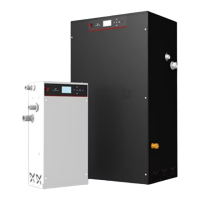GRUNDFOS INSTRUCTIONS
33
Any system connections will be subject to system pressure.
Take care when dismantling.
12.3 Disposal.
The PHT A unit has valuable recyclable components.
Disposal of this product or parts of it must be carried out according to the following guidelines:
Use the local public or private waste collection service.
The materials/components used need to be segregated according to the disposal
receivers’ requirements.
In case such waste collection services do not exist or cannot handle the materials used
in the product, please deliver the product or any hazardous materials from it to your
nearest Grundfos company or service workshop.
Local and National environmental legislation must always be complied with.
13.0 Fault Finding Guide.
It has been more than 12 months since
the unit was last serviced.
Arrange for an engineer to service the unit.
Once a full service has been performed, ensure
that the service date is reset.
The water in the break tank has fallen
below the Low Water Float Switch(DI1).
Check the water supply to the unit and ensure
that the float valve is operating/set up correctly.
Once the water level has been restored, wait up
to 2 minutes for the fault to reset.
If the fault does not reset, check the function of
the Low Water Float Switch (DI1).
The water in the break tank has risen
above the High Water Float Switch(DI2).
Check the water level in the tank.
Ensure that the float valve is operating/set up
correctly.
If the break tank is being back-filled from the
system, the pump non return valves should be
inspected for damage/debris.
Once the water level has been restored, wait up
to 2 minutes for the fault to reset.
If the fault does not reset, check the function of
the High Water Float Switch (DI2).
The glycol in the glycol tank has fallen
below the Low Glycol Float Switch(DI3).
Add more glycol to the glycol tank.
If the fault does not reset, check the function of
the Low Glycol Float Switch(DI3).
The system pressure has fallen below the
[System Low Pressure Alarm ON] set
point.
Check that the isolation valve to the system is
open.
Check the pressure reading against a mechanical
gauge if one is available.
If the pressure needs to be increased
substantially, add more water via a filling loop.
The system pressure has risen above the
[System High Pressure Alarm ON] set
point.
Check that the isolation valve to the system is
open.
Check the pressure reading against a mechanical
gauge if one is available.
Check if the filling loops have been left open.
Drain water from the system via a suitable drain
point until the correct pressure is restored.
If the fault reoccurs, inspect the system
expansion vessel and check its pre-charge
pressure.

